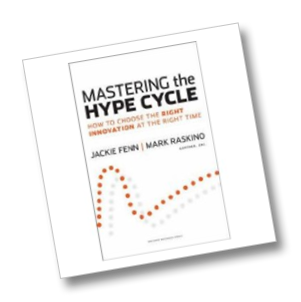I explained in my recent Knowledge Infusion webinar that I think web 2.0 and social networking tools can lead to transformational changes in organisations, and made the same point in show 001 of TalkingHR.
But do these opportunities really exist, or am I just falling for the hype / bubble around web 2.0?
I've had this question at the back of my mind for a while (since someone challenged me with a comment on this blog back in April), so I was pleased to receive a copy of Gardner's book, 'Mastering the Hype Cycle'.
I first came across the hype cycle when Jim Holincheck very kindly sent me a copy of Gartner's report, 'Hype Cycle for Human Capital Management Software' last year.
However, the book explains that the cycle was actually developed in 1995 while looking at the common patterns involved in the introduction of new technologies such as artificial intelligence, video on demand and the 'newly emerging world wide web'. I missed it as I was just moving out of IT into HR at that time.
A bit like the S curve, the hype cycle shows that innovation adoption does not happen as a straight line but follows a predictable curve, travelling through the following five phases:
1. "Technology Trigger"
The first phase of a Hype Cycle is the "technology trigger" or breakthrough, product launch or other event that generates significant press and interest.
2. "Peak of Inflated Expectations"
In the next phase, a frenzy of publicity typically generates over-enthusiasm and unrealistic expectations. There may be some successful applications of a technology, but there are typically more failures.
3. "Trough of Disillusionment"
Technologies enter the "trough of disillusionment" because they fail to meet expectations and quickly become unfashionable. Consequently, the press usually abandons the topic and the technology.
4. "Slope of Enlightenment"
Although the press may have stopped covering the technology, some businesses continue through the "slope of enlightenment" and experiment to understand the benefits and practical application of the technology.
5. "Plateau of Productivity"
A technology reaches the "plateau of productivity" as the benefits of it become widely demonstrated and accepted. The technology becomes increasingly stable and evolves in second and third generations. The final height of the plateau varies according to whether the technology is broadly applicable or benefits only a niche market
The book provides some good examples of hype cycles and also explain its causes, which include:
Social Contagion
"Although we might not like to admit it, we humans are at our core extraordinarily sensitive to what others around us are doing and saying. We want to be seen as individuals, yet not be perceived as too different.
Our tendency to be influenced by others probably originates from raw survival needs. Early humans who joined the crowd fleeing from an unseen enemy probably lived to tell the tale. If they insisted on validating the appropriateness of their cave colleague's behaviour through personal research, they probably found themselves wiped out of the gene pool by a herd of stampeding mammoths."
Zeitgeist
"[This is] a common social framework of attitudes, outlook, values, and expectations... Innovations that fit within the framework are more likely to attract attention and generate excitement than those that take us in a fundamentally different direction."
The book lists the dangers inherent in adopting new technology (adopting too early, giving up too soon, adopting too late. and hanging on too long). However, the movements in the cycle also provide opportunities, for example in the recruitment of:
- Scarce talent looking to sell their knowledge and skills at a premium near the peak of the cycle
- Demotivated but highly experienced talent during the trough
- Talent with considerable relevant experience who want to stay aligned with a specific innovation as it moves from slope to plateau.
There's also a process to navigate the cycle: scope, track, rank, evaluate, evangelise and transfer (STREET).
One point I was pleased to see Gartner make, and that I completely agree with is that "the hype cycle really isn’t about technology, but about the human reaction to anything new – in particular the mismatch between expectations and reality".
So what about web 2.0? Well, the book doesn't really deal with this, and I guess Gartner doesn't want to impact sales of its recent emerging technologies report.
But according to other bloggers, this report shows corporate blogging, wikis and social network analysis entering into the slope of enlightenment.
Microblogging is still in the technology trigger stage (and prediction markets seem to have dropped off the cycle since Gartner's 2006 report).
But web 2.0 is now entering the trough of disillusionment, so we may be going to see a bust in this bubble quite soon. But Gartner still sound quite upbeat:
"Although Web 2.0 is now entering the Trough of Disillusionment, it will emerge within two years to have transformational impact, as companies steadily gain more experience and success with both the technologies and the cultural implications,"
What do you think? It'd be great to have your comments on this.




















I sense there's a huge variation between organisations in terms of where they are on the curve. Some aren't even on it at all. he gap will widen between the 'Web 1.0' and 'Web 2.0/ Enterprise 2.0' firms in terms of extent and sophistication of use of social software. I believe there will be an impact on competitive advantage, but how much is hard to say.
ReplyDeleteThanks for your comment Simon. Yes, I agree, time will tell. Though I do think the case studies which already exist (some of which are described on this blog) already tell a fairly compelling story.
ReplyDelete